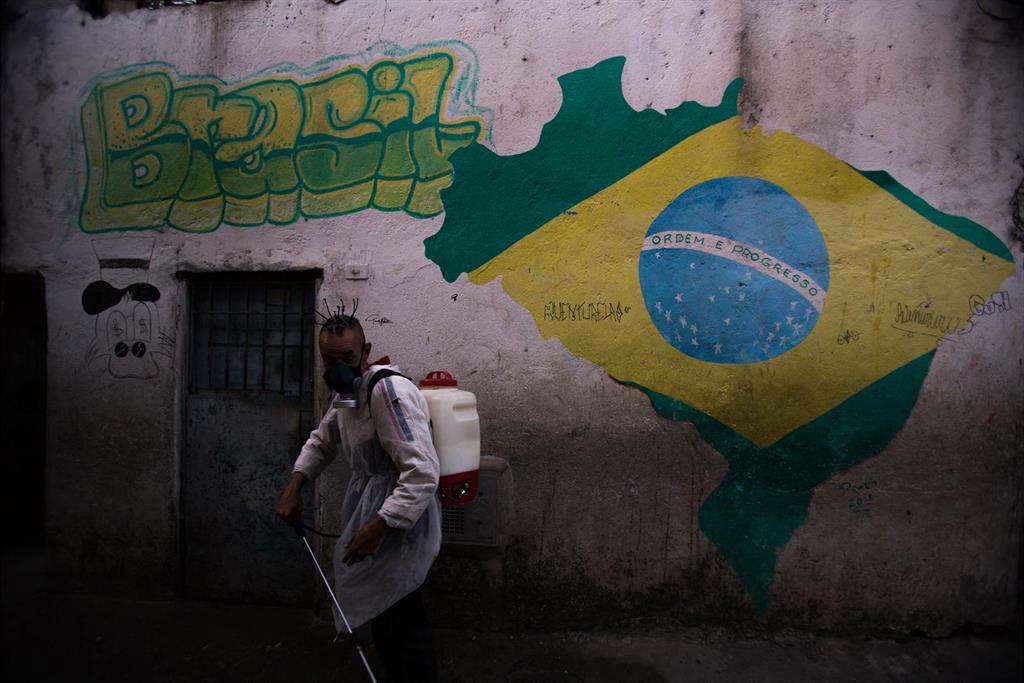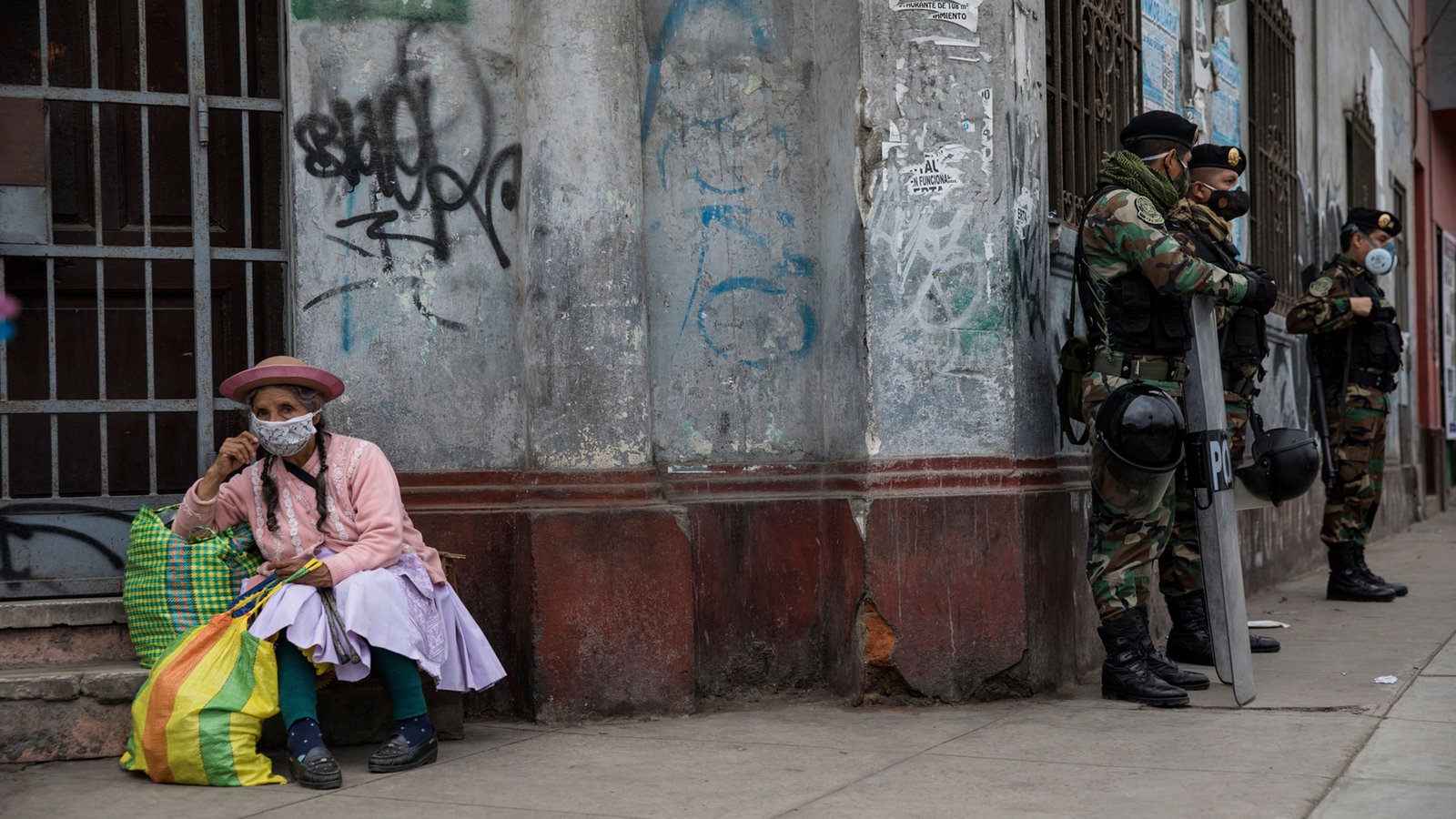RIO DE JANEIRO, BRAZIL – The coronavirus has caused over 590,000 deaths worldwide since it emerged in December 2019, according to a report released at 3 PM GMT on Friday, July 17th, based on data published by Johns Hopkins University. In Latin America, the cumulative number of deaths rose to 154,669.

Since the start of the pandemic, more than 13.8 million cases of infection have been reported in 191 countries or territories, while in the region there are 3,619,146 infected people. In Latin America, Brazil is still the country with the highest number of confirmed cases, with 2,012,151.
Country-by-country developments in Latin America:
Brazil (2,012,151 cases – 76,688 deaths)
Brazil, amid the de-escalation, on Thursday passed the two million mark for confirmed cases of COVID-19, a disease spreading at different rates in the country in the world second-most affected by the pandemic.
Four months after recording the first victim of the coronavirus, the Latin American giant now totals 76,688 deaths from the pathogen, 1,322 of them recorded in the last 24 hours, as well as a total of 2,012,151 infections, according to the latest report by the Ministry of Health.
The governor of the Brazilian state of Sergipe, Belivaldo Chagas, announced that he tested positive for the coronavirus, making him the ninth regional leader to contract COVID-19. The country’s most famous infected person is President Jair Bolsonaro, one of the most skeptical rulers on the seriousness of the pandemic and who went so far as to refer to COVID-19 as a “minor flu”.
Peru (341,586 cases – 12,615 deaths)
Peru, the country ranked fifth in the world and second in Latin America for the most confirmed cases of COVID-19, on Thursday reached over two million detection tests for the novel coronavirus on its population, bringing its cumulative number of infections to 341,586.
With nearly 33 million inhabitants, in the last report the Andean country recorded 3,862 new infections and the death of 198 more patients, which adds up to 12,615 deaths from the SARS-CoV-2 virus in the country, according to the Peruvian Ministry of Health (MINSA).
The new Minister of Health, Pilar Mazzetti, announced that several months of “hard work” will be required in Peru to tackle a “highly changing” virus such as Covid-19. She stated that “in this part of the pandemic, we are going to experience an ongoing situation, in which we all need to accept that this has never happened before and we don’t know how things change, because this virus is rare and ever-changing.”
Mexico (324,041 cases – 37,574 deaths)
Mexico reported 668 deaths from COVID-19 in addition to 6,406 infections in the last 24 hours, to reach 37,574 deaths and 324,041 confirmed cases, health authorities reported on Thursday. They pointed out that there was a two percent increase in the number of infections in the last 24 hours, while deaths rose by 1.8 percent.
The Director-General of Epidemiology of the Mexican Ministry of Health, José Luis Alomía, reported in a press conference that of the cumulative cases since the pandemic was declared in the country on February 28th, 28,786 correspond to patients with symptoms of COVID-19 developed in the past 14 days.
Chile (323,698 cases – 7,290 deaths)
Chile’s Minister of Health, Enrique Paris, announced on Thursday that the coronavirus death toll would change as of Friday, after reporting 2,475 new cases in the country, bringing the total number of infections to 323,698, with 104 deaths recorded in the Civil Registry, bringing the total to 7,290.
“Starting tomorrow, the report on confirmed deaths will be based on the figures prepared by the DEIS (Department of Statistics and Health Information, part of the Chilean Ministry of Health),” said the Secretary of State.
Up to now, there were two reports of confirmed deaths by COVID-19: a daily count by the Ministry of Health, which was part of the daily balance and only considered deaths registered in the Civil Registry; and a weekly figure, provided by the DEIS, which was part of the epidemiological report and included more data sources, which resulted in a discrepancy between both balances.
Colombia (165,169 cases – 6,164 deaths)
The coronavirus pandemic reached unprecedented levels in Colombia on Thursday, with record setting 8,037 infections and 215 deaths.
According to the Health Ministry’s daily report, the department of Atlántico was the region with the most cases, with 1,967, followed by Bogotá (1,767), Antioquia (933), Bolívar (786), Valle del Cauca (398), Cundinamarca (355), Sucre (280), Nariño (254), Magdalena (252), Tolima (141), Santander (110), Córdoba (108), and Cesar (101).
Argentina (114,783 cases – 2,112 deaths)
Argentina recorded 62 deaths from COVID-19 on Thursday, and the number of deaths has already reached 2,112, while 3,624 new cases were confirmed, bringing the total to 114,783 infections in the country since the start of the pandemic.
According to the Ministry of Health’s Thursday report, there were fewer infections and deaths than on Wednesday, when Argentina experienced its worst day ever in this pandemic, in both records.
Ecuador (71,365 cases – 5,207 deaths)
Ecuador has recorded a total of 71,365 COVID-19 infections, with more than a thousand new cases in the last 24 hours, while the province of Pichincha, of which Quito is the capital, has reported 11,269 infections, according to the latest official report.
Official data also report 5,207 confirmed deaths, while the probable deaths from the virus stand at 3,355.

Bolivia (54,156 cases – 1,984 deaths)
The congestion of the municipal cemetery set up in the Bolivian city of Santa Cruz, the most affected by COVID-19, to bury the deceased from the disease, forced the construction of a second cemetery and the preparation of a third one for these burials.
The space set aside in La Cuchilla cemetery by the Santa Cruz City Hall for the burial of COVID-19’s victims exceeded its capacity, so another plot was opened in Los Cusis, another cemetery run by the municipality.
Municipal employees and machines are working tirelessly in Los Cusis digging up the individual graves that will be the last resting place of the deceased.
Panama (50,373 cases – 1,000 deaths)
Panama is ready and only waiting for the approval of biosafety protocols for the reopening of its flight operations from Tocumen International Airport, the country’s main airport, which suspended international flights over three months ago due to the COVID-19 pandemic.
This was stated by authorities and airline representatives from the country in a virtual meeting organized by the executive board of the International Air Transport Association (IATA).
Dominican Republic (48,743 cases – 941 deaths)
The Dominican Republic president-elect, Luis Abinader, said “it is time for all Dominicans to unite,” after receiving his confirmation from the Central Electoral Board (JCE) as the winner of the July 5th presidential election.
Speaking after receiving the document, Abinader recalled that “we are in the midst of a health emergency and an economic crisis,” which is why, as of August 16th when he takes office, “our administration will focus on gathering the most capable professionals, regardless of their party, to help in the task of protecting the people’s health and reactivating the country’s economy”.
Guatemala (32,939 cases – 1,404 deaths)
The director of the Presidential Commission against the Coronavirus Emergency in Guatemala (COPRECOVID), Dr. Edwin Asturias, warned on Thursday that the number of deaths from COVID-19 in the country will be around 9,657 by October, according to estimates.
During the presentation of his fourth biweekly report to the Congress plenary – the first monthly document produced by the COPRECOVID -, Asturias assured that the projection was prepared by the University of Washington (USA), which deferred “the peak” of the pandemic in Guatemala to October.
Honduras (30,867 cases – 835 deaths)
On Thursday, the Honduran Parliament passed a decree authorizing the Ministry of Finance to implement measures to reduce public spending in response to the country’s economic crisis, which has been exacerbated by the COVID-19 pandemic.
The aim of the decree, passed in a virtual session, is to implement all budgetary and financial operations required to “reduce the General Revenue and Expenditure Budget by the appropriate percentage,” the Legislative Branch said in a statement.
El Salvador (11,207 cases – 309 deaths)
The University of El Salvador (UES) has developed a data panel with information on transmission, infection, and coronavirus infection rates in the Central American country.
The dean of the Faculty of Natural Sciences and Mathematics, Mauricio Lovo, explained during a radio interview that the data projections are based on several time-series models (Gompertz, Triple Exponential Smoothing, and Box-Jenkins) which project the behavior of infections in the country by days, weeks and months, in order to take the appropriate measures.
Venezuela (10,854 cases – 104 deaths)
At least 172 people have died from COVID-19 in Venezuela since the start of the pandemic, which is almost double the 100 deaths reported by the government, opposition deputy José Manuel Olivares said on Thursday.
“To date, the number of deaths, the number of Venezuelans who unfortunately have lost their lives and are not among the data reported by the dictatorship stands at 72,” said Olivares in an online press conference.
Thus, Venezuela would have a mortality rate from the disease of about two percent, which is a rate “more similar” to that of the region.

Costa Rica (9,546 cases – 42 deaths)
Costa Rican Minister of Health, Daniel Salas, reported that the country recorded 504 new positive cases of COVID-19 and three deaths, which represents an acceleration compared to previous projections.
Costa Rica reached 9,546 positive cases accumulated during the COVID-19 pandemic, as well as 42 deaths among those aged 26 to 94, with the last ten deaths occurring between last Monday and Thursday.
Haiti (6,948 cases – 145 deaths)
The Government of Haiti called on its population to “reduce risks” in order to prevent a resurgence of the SARS-CoV-2 coronavirus in the country, taking stock of the health situation four months after the first case was reported in the Caribbean nation.
“We are going to reduce the risks so that a second wave will not occur in the country,” Haitian Minister of Health Marie Gréta Roy Clément said of the recent decision to reopen commercial flights in addition to churches and schools.
Paraguay (3,342 cases – 27 deaths)
The return of the Paraguayan Apertura soccer tournament, scheduled for Friday, is hampered by the suspension of three games after the emergence of several coronavirus infections in teams: 12 de Octubre, San Lorenzo, and Guaraní.
The canceled games include Friday’s matches between General Díaz and San Lorenzo, and Saturday’s between Guaireña-Guaraní and Sol de América vs. 12 de Octubre.
Nicaragua (3,147 cases – 99 deaths)
A fifth group of 88 Nicaraguans left Panama on Wednesday, where they were deprived of their livelihoods because of the COVID-19 pandemic, to return to their country of origin, but there are still 422 waiting at the border with Costa Rica, Panamanian immigration authorities reported.
Nicaraguan citizens have been trying to return home for weeks, on a trip that requires coordination between Panama, Costa Rica and Nicaragua, after running out of resources in the country because of the crisis generated by the pandemic.
Cuba (2,440 cases – 87 deaths)
The whole Cuban territory except Havana and its neighboring province of Mayabeque will enter next Monday the third and last stage of reopening in the aftermath of the coronavirus pandemic, although the borders will remain closed to foreigners until the situation improves in the capital, where infections are still being reported.
Cuban Prime Minister Manuel Marrero reported on Thursday that Havana will remain in phase 1 until further notice, which includes the re-establishment of urban public transport, the limited reopening of restaurants and bars, and access to beaches, among other measures.
Uruguay (1,026 cases – 32 deaths)
The Clasico match between Uruguay’s two major soccer teams, Nacional and Penarol, will mark the return of Uruguayan soccer to the competition on the weekend of August 8th and 9th after nearly five months of inactivity because of the COVID-19, officials said.
During a press conference, the president of the Uruguayan Football Association (AUF), Ignacio Alonso, agreed with the resolution that emerged from a meeting held in Montevideo with members of the National Sports Secretariat (SND) and the Ministry of Public Health (MSP).
Jamaica (765 cases – 10 deaths)
Jamaica has welcomed 35,000 visitors since its borders reopened on June 15th, according to the Caribbean island’s Tourism Minister Edmund Bartlett.
In statements collected by local media, the official said that the island expects to welcome another 30,000 tourists by the end of July, which will represent nearly US$80 million in foreign currency for the local economy.

